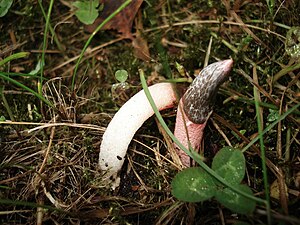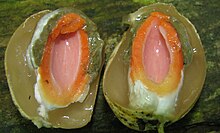Common dog tail
| Common dog tail | ||||||||||||
|---|---|---|---|---|---|---|---|---|---|---|---|---|

Common dog tail ( Mutinus caninus ) |
||||||||||||
| Systematics | ||||||||||||
|
||||||||||||
| Scientific name | ||||||||||||
| Mutinus caninus | ||||||||||||
| Fr. |
The common dog's tail ( Mutinus caninus ) is a species of fungus from the family of stinkhorn relatives (Phallaceae). The Latin name of the fungus Mutinus caninus means "small dog penis" and refers to the similar appearance of the fruiting body to the penis of dogs . The word “ tail ” is also an older synonym for “penis”.
features
The fruiting bodies of the common dog's rod initially form egg-shaped, 3.5 cm high and 2.5 cm wide witch eggs from which the 6–15 cm high, approximately 1 cm thick receptaculum breaks out in the course of ripening . The receptacle is brightly colored, the color spectrum ranges from white to pale ocher or pale pink. The red-colored tip of the receptaculum is covered with the olive-brown gleba . The smell is weak.
Species delimitation
From North America were mutinus elegans ( Mutinus elegans ) and the mutinus ravenelii ( Mutinus ravenelii ) introduced . These differ from the common dog's tail by a red receptacle and a strong scent of carrion.
ecology
The common dog's rod is a saprobiontic soil and wood dweller that can be found in Central Europe in various deciduous and coniferous forests, parks and gardens on fresh to moist, humus-rich soils, wood waste or rotten tree stumps. In Central Europe, the fruiting bodies usually appear gregarious in summer and autumn.
distribution
The common dog's tail occurs in Europe, the Caucasus, East Asia and North America. In Europe it is widespread from the Mediterranean region to Ireland, Scotland and Scandinavia.
meaning
The common dog's tail is non-toxic, but is out of the question as an edible mushroom because of its disgusting smell for humans.
literature
- Josef Breitenbach, Fred Kränzlin (Ed.): Mushrooms of Switzerland. Contribution to knowledge of the fungal flora in Switzerland. Volume 2: Heterobasidiomycetes (gelatinous mushrooms), Aphyllophorales (non-leaf mushrooms), Gastromycetes (belly mushrooms). Mykologia, Luzern 1986, ISBN 3-85604-020-X .
- Ewald Gerhard: Mushrooms. Determine accurately in three steps . BLV Buchverlag GmbH & Co. KG, Munich 2012, ISBN 978-3-8354-0946-0
- German Josef Krieglsteiner (Eds.), Andreas Gminder , Wulfard Winterhoff: Die Großpilze Baden-Württemberg . Volume 2: Stand mushrooms: inguinal, club, coral and stubble mushrooms, belly mushrooms, boletus and deaf mushrooms. Ulmer, Stuttgart 2000, ISBN 3-8001-3531-0 .
Individual evidence
- ↑ Gerhardt 2012, p. 218.
